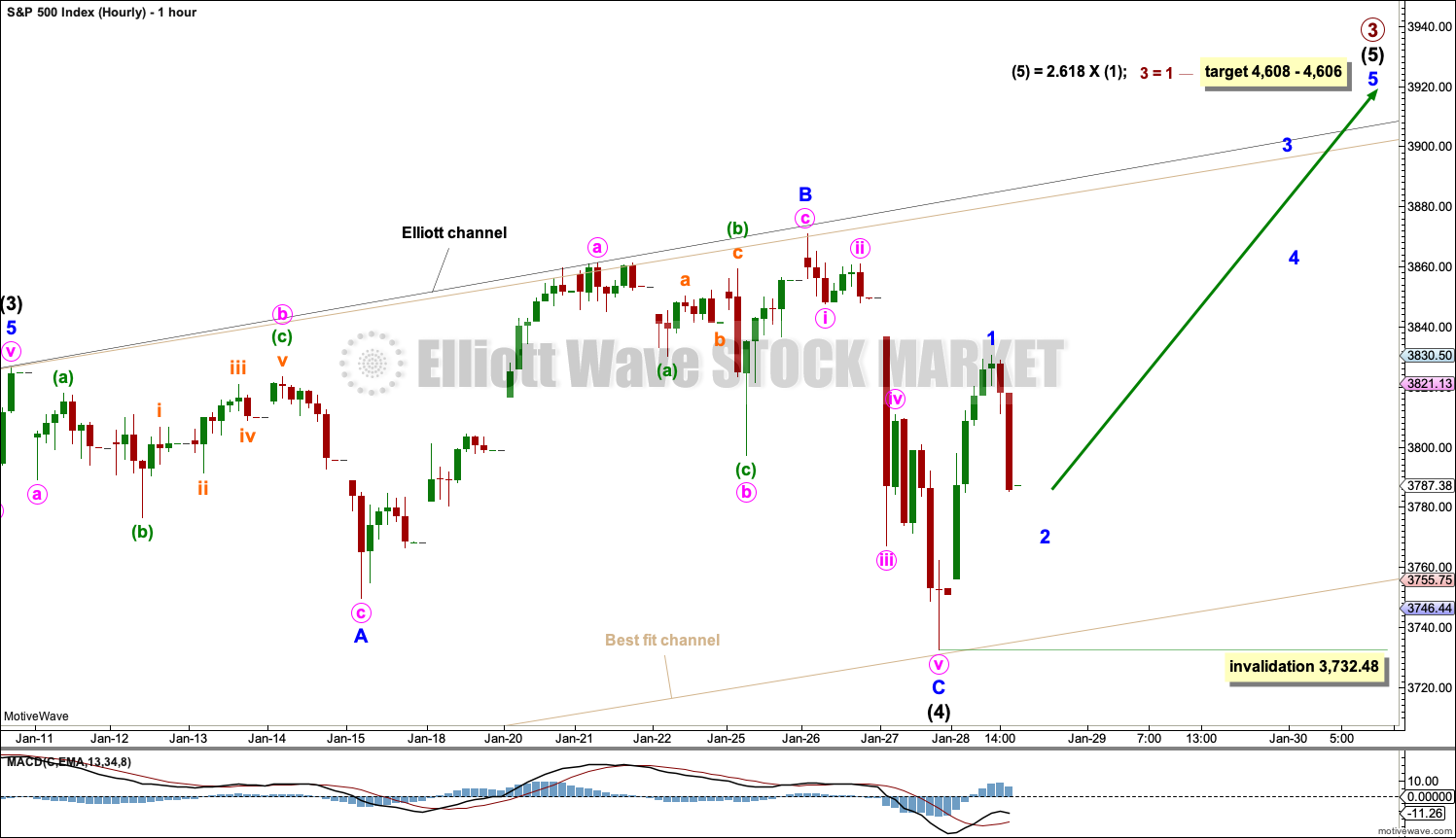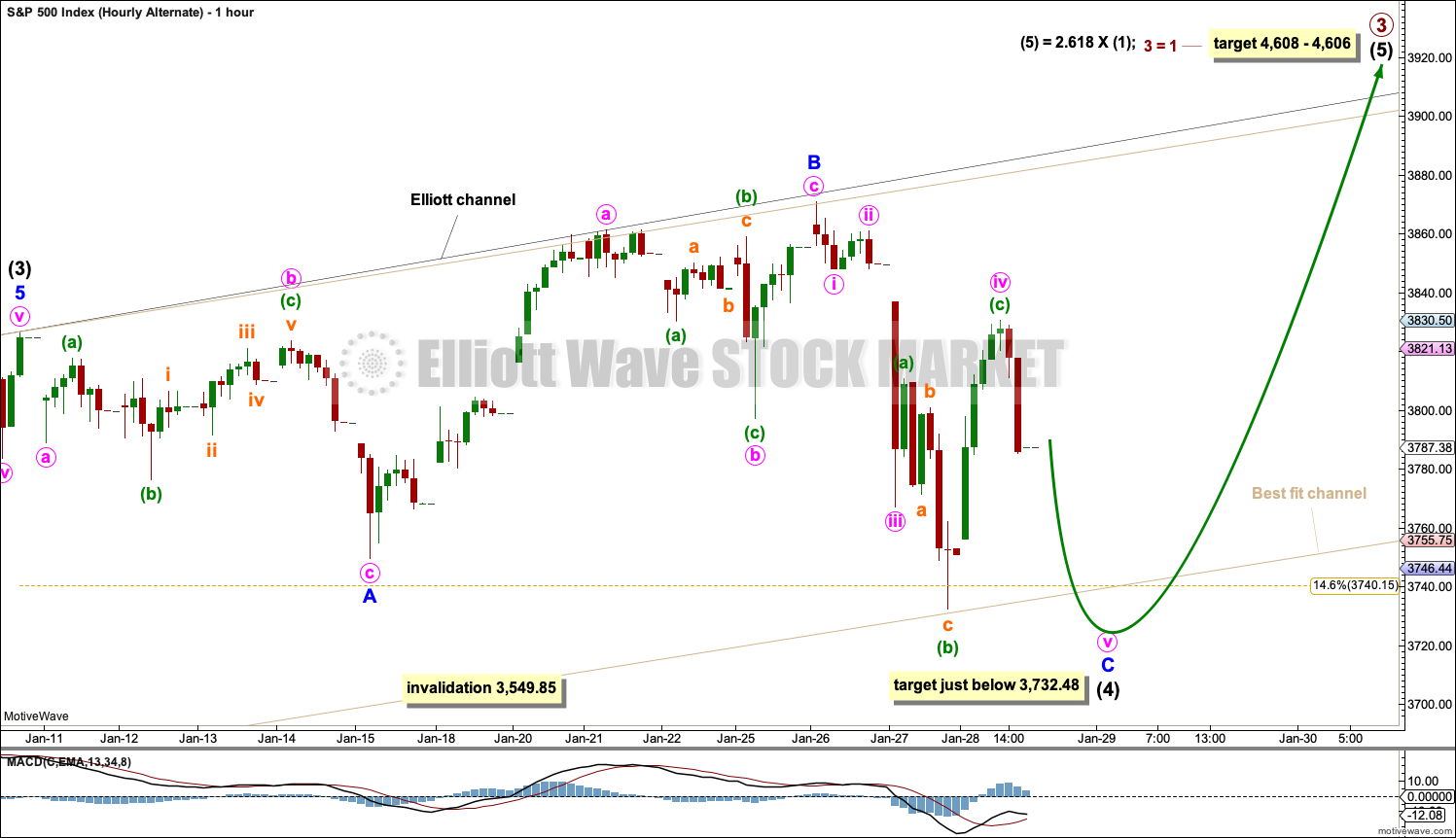S&P 500: Elliott Wave and Technical Analysis | Charts – January 28, 2021
A strong bounce suggested the pullback of the prior session may be complete.
At the daily chart level, the Elliott wave count remains the same.
Summary: Both main and alternate wave counts expect the low of the 30th of October to not be breached for many months or years.
The next target for the upwards trend is at 4,606 – 4,608.
An alternate wave count at the weekly chart level has an about even probability with the main weekly chart.
The biggest picture, Grand Super Cycle analysis, is here.
Monthly charts are last updated here with video here.
MAIN WAVE COUNT
WEEKLY CHART
Cycle wave V may last from one to several years. So far it is in its tenth month.
This wave count may allow time for the AD line to diverge from price as price makes final highs before the end of the bull market. The AD line most commonly diverges a minimum of 4 months prior to the end of a bull market. A longer divergence is positively correlated with a deeper bear market. A shorter divergence is positively correlated with a more shallow bear market. With zero divergence at this stage, if a surprise bear market does develop here, then it would likely be shallow.
Cycle wave V would most likely subdivide as an impulse. But if overlapping develops, then an ending diagonal should be considered. This chart considers the more common impulse.
Primary waves 1 and 2 may be complete.
Primary wave 3 may only subdivide as an impulse.
There is already a Fibonacci ratio between cycle waves I and III within Super Cycle wave (V). The S&P500 often exhibits a Fibonacci ratio between two of its actionary waves but rarely between all three; it is less likely that cycle wave V would exhibit a Fibonacci ratio. The target for Super Cycle wave (V) to end would best be calculated at primary degree, but that cannot be done until all of primary waves 1, 2, 3 and 4 are complete.
DAILY CHART
Primary waves 1 and 2 may both be complete. Primary wave 3 may be underway.
Primary wave 3 may only subdivide as an impulse.
It is possible that intermediate waves (3) and (4) may both now be complete. Intermediate wave (4) may have ended at support about the lower edge of the weekly best fit channel and at the lower edge of the best fit channel.
Intermediate wave (2) was a very deep zigzag lasting 14 sessions. Intermediate wave (4) may be a complete expanded flat lasting 12 sessions. There is alternation and good proportion between intermediate waves (4) and (2).
If it continues lower, then intermediate wave (4) may not move into intermediate wave (1) price territory below 3,549.85.
Primary wave 1 looks extended. The target for primary wave 3 expects it to also be extended.
HOURLY CHART
Intermediate wave (4) may be complete as an expanded flat. This exhibits alternation with the zigzag of intermediate wave (2). There is now excellent proportion between intermediate waves (2) and (4).
On the five minute chart, minute wave v will subdivide as a five wave impulse.
Minor wave 2 within intermediate wave (5) may not move beyond the start of minor wave 1 below 3,732.48.
ALTERNATE HOURLY CHART
It is also possible that intermediate wave (4) may be incomplete and may require one final low for minute wave v. Minute wave v would need to move at least slightly below the end of minute wave iii at 3,732.48 to avoid a truncation. Support at the lower edge of the beige best fit channel may force intermediate wave (4) to be relatively shallow.
Intermediate wave (4) may not move into intermediate wave (1) price territory below 3,549.85.
ALTERNATE WAVE COUNT
WEEKLY CHART
This wave count is the same as the first weekly chart with the exception of the degree of labelling within cycle wave V.
If the degree of labelling within cycle wave V is moved down one degree, then only primary wave 1 may be currently unfolding. When primary wave 1 may be complete, then a multi-week pullback or consolidation may begin for primary wave 2. Primary wave 2 may not move beyond the start of primary wave 1 below 2,191.86.
This wave count is more bullish than the main weekly chart. It expects that cycle wave V may be in an earlier stage and may yet last many more years than the main weekly chart expects it to. These two weekly wave counts are of an even probability. In coming months to years classic technical analysis will be used to judge the probability of these two weekly wave counts.
DAILY CHART
This wave count is the same as the first daily chart except the degree of labelling is one degree lower within primary wave 1.
The target for a third wave up to end is the same.
TECHNICAL ANALYSIS
WEEKLY CHART
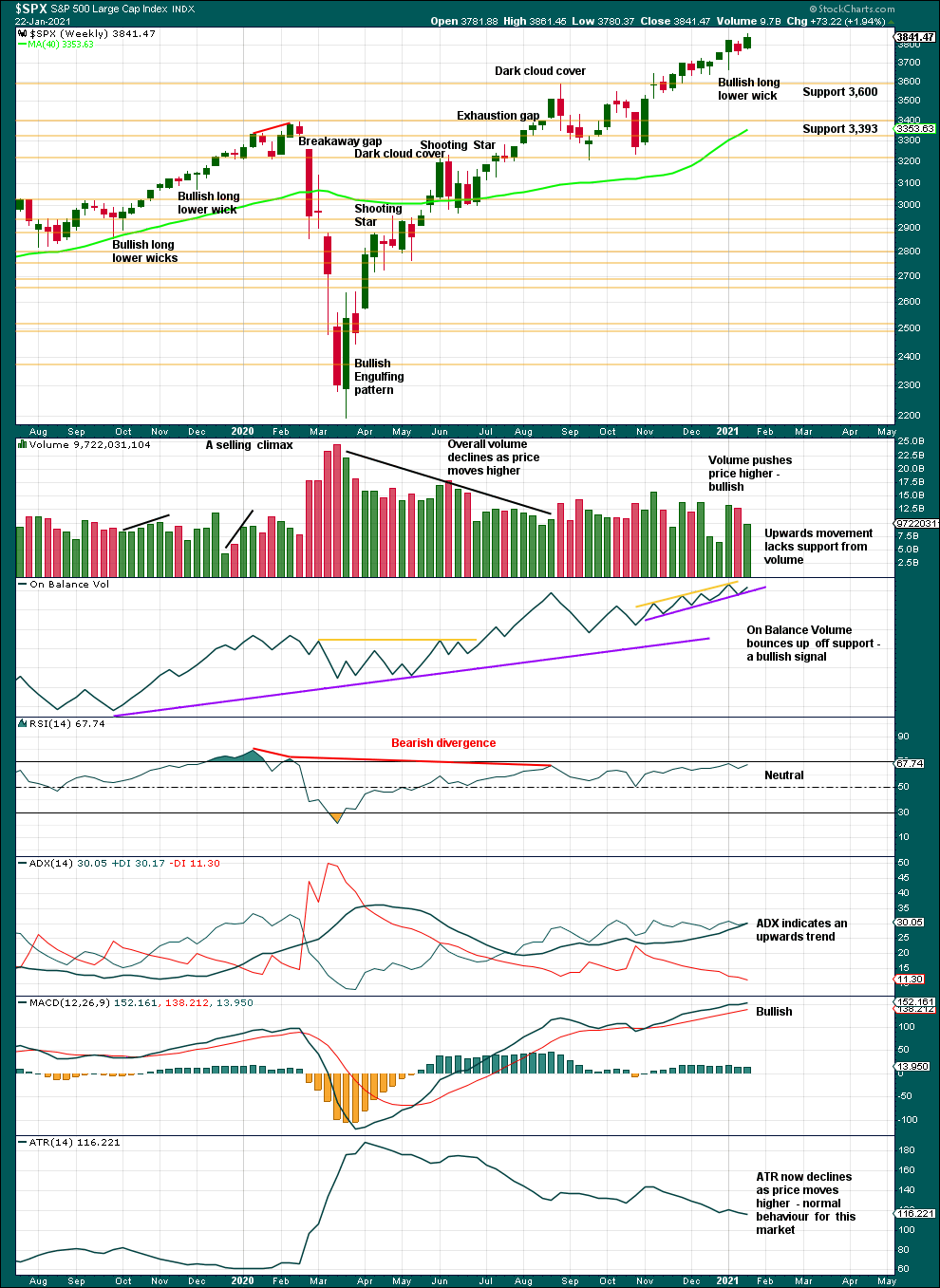
Click chart to enlarge. Chart courtesy of StockCharts.com.
This chart is bullish and still supports the main Elliott wave count. All of volume, ADX and MACD are bullish. There is no bearish candlestick reversal pattern. Conditions are still not extreme. There is room for this upwards trend to continue.
On Balance Volume now has a new range.
A lack of support last week from volume for upwards movement is not of any concern in current market conditions.
DAILY CHART
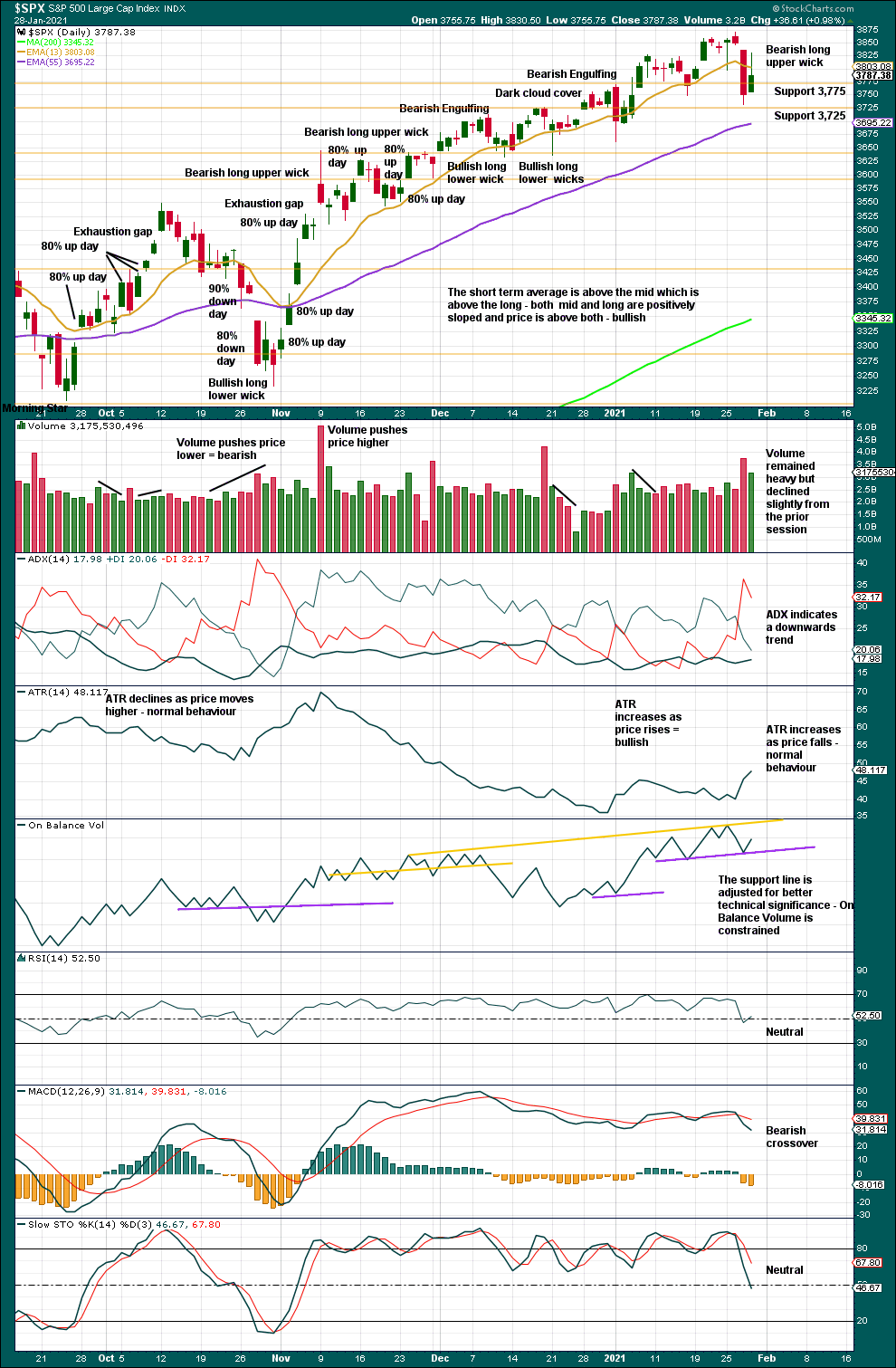
Click chart to enlarge. Chart courtesy of StockCharts.com.
Over the last two sessions up volume has dominated and volume remains relatively heavy, although there was some decline for this last session. Overall, volume is bullish. However, ADX now indicates a downwards trend.
BREADTH – AD LINE
WEEKLY CHART

Click chart to enlarge. Chart courtesy of StockCharts.com. So that colour blind members are included, bearish signals will be noted with blue and bullish signals with yellow.
Breadth should be read as a leading indicator.
Lowry’s Operating Companies Only AD line has made a new all time high on the 20th of January. This is a strong bullish signal and supports the main Elliott wave count.
Large caps all time high: 3,870.90 on January 26, 2021.
Mid caps all time high: 2,482.63 on January 25, 2021.
Small caps all time high: 1,258.83 on January 25, 2021.
Last week both price and the AD line have made new all time highs. Upwards movement in price has support from rising market breadth. This is bullish.
Today’s upwards movement was led by large and mid caps. This is bearish as it is small caps that tend to lead early in a trend.
DAILY CHART
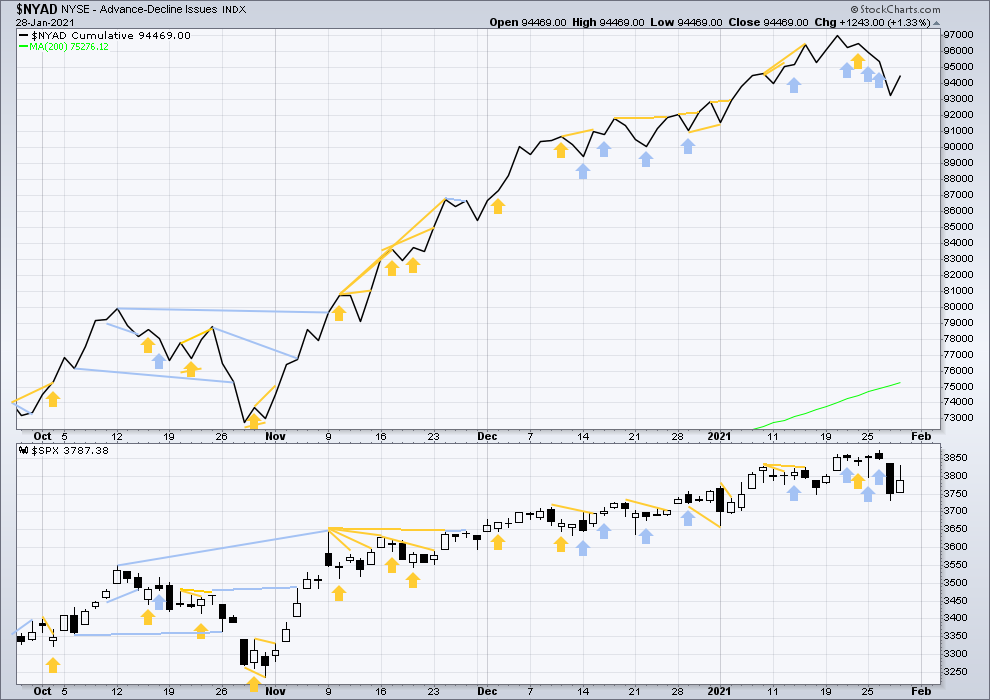
Click chart to enlarge. Chart courtesy of StockCharts.com. So that colour blind members are included, bearish signals will be noted with blue and bullish signals with yellow.
Today both price and the AD line have moved higher. There is no new divergence.
VOLATILITY – INVERTED VIX CHART
WEEKLY CHART

Click chart to enlarge. Chart courtesy of StockCharts.com. So that colour blind members are included, bearish signals will be noted with blue and bullish signals with yellow.
Inverted VIX remains well below all time highs. The all time high for inverted VIX was in the week beginning October 30, 2017. There is over 3 years of bearish divergence between price and inverted VIX. There is all of long, mid and short-term bearish divergence. This bearish divergence may develop further before the bull market ends. It may be a very early indicator of an upcoming bear market, but it is not proving to be useful in timing.
Last week price has made new all time highs, but inverted VIX has failed to make new short-term highs. There is all of short, mid and long-term bearish divergence between price and inverted VIX.
Comparing VIX and VVIX: Both VIX and VVIX have moved lower. There is no new divergence.
DAILY CHART
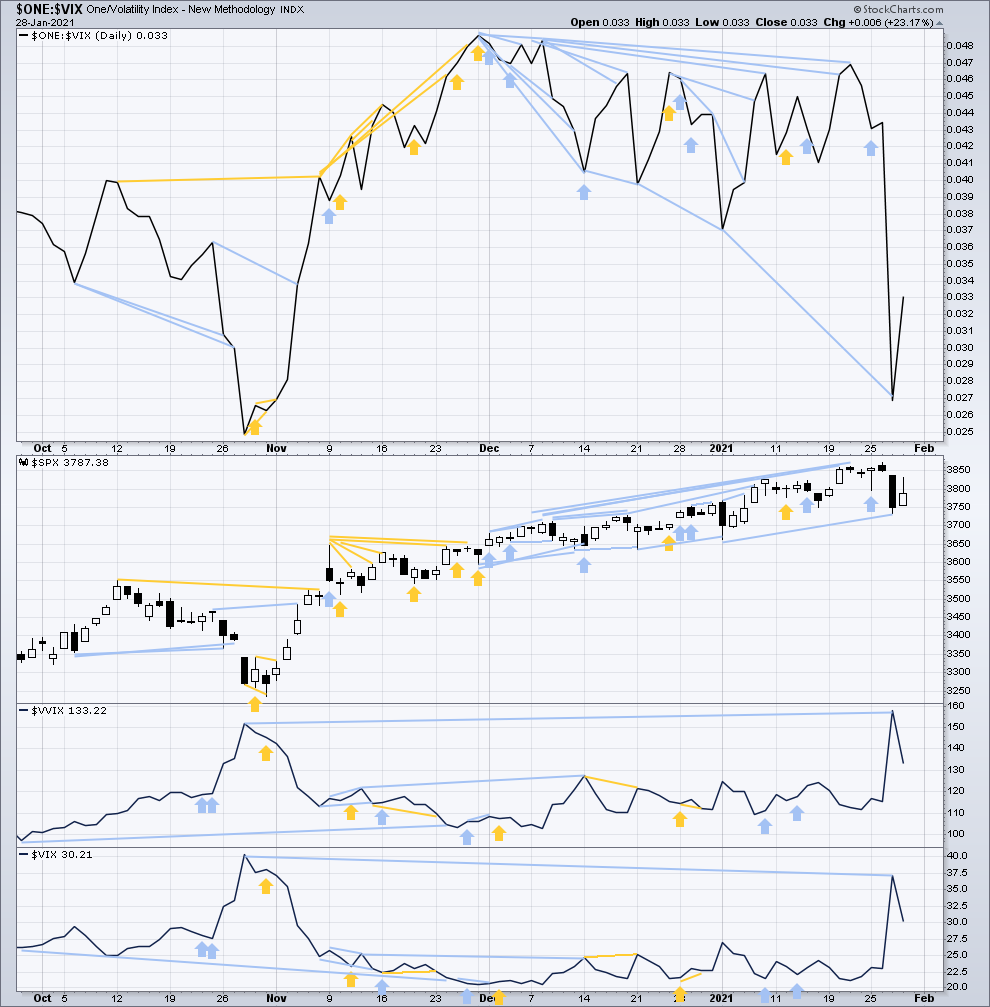
Click chart to enlarge. Chart courtesy of StockCharts.com. So that colour blind members are included, bearish signals will be noted with blue and bullish signals with yellow.
Today both price and inverted VIX have moved higher. Neither have made new short-term highs. There is no new divergence.
Comparing VIX and VVIX at the daily chart level: VVIX has made a new high above the high of October 28, 2020, but VIX has not. This divergence is bearish for the mid term. Both VIX and VVIX have for the last session moved lower. There is no new divergence.
DOW THEORY
Dow Theory confirms a new bull market with new highs made on a closing basis:
DJIA: 29,568.57 – closed above on 16th November 2020.
DJT: 11,623.58 – closed above on 7th October 2020.
Adding in the S&P and Nasdaq for an extended Dow Theory, confirmation of a bull market would require new highs made on a closing basis:
S&P500: 3,393.52 – closed above on 21st August 2020.
Nasdaq: 9,838.37 – closed above on June 8, 2020.
The following major swing lows would need to be seen on a closing basis for Dow Theory to confirm a change from bull to a bear market:
DJIA: 18,213.65
DJT: 6,481.20
Adding in the S&P and Nasdaq for an extended Dow Theory, confirmation of a new bear market would require new lows on a closing basis:
S&P500: 2,191.86
Nasdaq: 6,631.42
Published @ 07:27 p.m. ET.
—
Careful risk management protects your trading account(s).
Follow my two Golden Rules:
1. Always trade with stops.
2. Risk only 1-5% of equity on any one trade.
—
New updates to this analysis are in bold.



